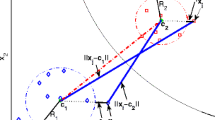Abstract
In this work we propose a generalization of the Support Vector Machine (SVM) method in which the separator is a curve, but the concept of margin and maximization of the margin is still present. The idea of using different functions for the separation has been explored in particular in the scope of hyperspheres. However, most of these proposals use two spheres, using concepts different from maximal margin or one sphere but with a poor performance when data from the classes have a linear shape. In this paper we present a formulation of the linear SVM that generalizes it to a spherical separation shape, but still maximizing the margin. A linear relaxation of this quadratic formulation is also presented. The performance of these two formulations for classification purpose is tested and the results are encouraging.
This work is funded by national funds through the FCT - Fundação para a Ciência e a Tecnologia, I.P., under the scope of the project UIDB/00297/2020 (Center for Mathematics and Applications).
Access this chapter
Tax calculation will be finalised at checkout
Purchases are for personal use only
Similar content being viewed by others
References
Uc irvine machine learning repository. https://archive-beta.ics.uci.edu/
Abe, S.: Support Vector Machines for Pattern Classification. Springer, London (2005). https://doi.org/10.1007/1-84628-219-5
Astorino, A., Fuduli, A., Gaudioso, M.: A fixed-center spherical separation algorithm with kernel transformations for classification problems. J. Glob. Optim. 48, 657–669 (2010). https://doi.org/10.1007/s10898-010-9558-0
Astorino, A., Fuduli, A., Gaudioso, M.: Margin maximization in spherical separation. Comput. Optim. Appl. 53, 301–322 (2012). https://doi.org/10.1007/s10589-012-9486-7
Astorino, A., Gaudioso, M.: A fixed-center spherical separation algorithm with kernel transformations for classification problems. Comput. Manag. Sci. 6, 357–372 (2009). https://doi.org/10.1007/s10287-007-0051-2
Cooper, P.W.: The hypersphere in pattern recognition. Inf. Control 5(4), 324–346 (1962). https://doi.org/10.1016/S0019-9958(62)90641-1, https://www.sciencedirect.com/science/article/pii/S0019995862906411
Corinna, C., Vladimir, V.: Support-vector networks. Mach. Learn. 20, 273–297 (1995). https://doi.org/10.1007/BF00994018
Dietterich, T.G.: Approximate statistical tests for comparing supervised classification learning algorithms. Neural Comput. 10(7), 1895–1923 (1998). https://doi.org/10.1162/089976698300017197
Gong, R., Wu, C., Chu, M.: Multi-class classification method based on support vector machine with hyper-sphere for steel surface defects. In: 2018 37th Chinese Control Conference (CCC), pp. 9197–9202 (2018). https://doi.org/10.23919/ChiCC.2018.8483656
Gong, R., Wu, C., Chu, M.: Steel surface defect classification using multiple hyper-spheres support vector machine with additional information. Chemom. Intell. Lab. Syst. 172, 109–117 (2017). https://doi.org/10.1016/j.chemolab.2017.11.018
Gong, R., Wu, C., Chu, M., Wang, H.: Twin pinball loss support vector hyper-sphere classifier for pattern recognition. In: 2016 Chinese Control and Decision Conference (CCDC), pp. 6551–6556 (2016). https://doi.org/10.1109/CCDC.2016.7532177
Hao, P.Y., Chiang, J.H., Lin, Y.H.: A new maximal-margin spherical-structured multi-class support vector machine. Appl. Intell. 30(2), 98–111 (2009). https://doi.org/10.1007/s10489-007-0101-z
Ketabchi, S., Moosaei, H., Razzaghi, M.: Linear approach for twin-hypersphere support vector machine. Adv. Model. Optim. 19, 79–85 (2017)
Chu, M., Liu, X., Gong, R., Zhao, J.: Support vector machine with quantile hyperspheres for pattern classification. PLoS ONE 14(2) (2019). https://doi.org/10.1371/journal.pone.0212361
Peng, X.: Least squares twin support vector hypersphere (LS-TSVH) for pattern recognition. Expert Syst. Appl. 37(12), 8371–8378 (2010). https://doi.org/10.1016/j.eswa.2010.05.045, https://www.sciencedirect.com/science/article/pii/S0957417410004562
Peng, X.: A spheres-based support vector machine for pattern classification. Neural Comput. Appl. 31(1), 379–396 (2017). https://doi.org/10.1007/s00521-017-3004-x
Peng, X., Xu, D.: A twin-hypersphere support vector machine classifier and the fast learning algorithm. Inf. Sci. 221, 12–27 (2013). https://doi.org/10.1016/j.ins.2012.09.009, https://www.sciencedirect.com/science/article/pii/S0020025512005919
Peng, X., Xu, D.: Twin support vector hypersphere (TSVH) classifier for pattern recognition. Neural Comput. Appl. 24(5), 1207–1220 (2013). https://doi.org/10.1007/s00521-012-1306-6
Sahinidis, N.V.: BARON 21.1.13: Global Optimization of Mixed-Integer Nonlinear Programs, User’s Manual (2017)
Strack, R., Kecman, V., Strack, B., Li, Q.: Sphere support vector machines for large classification tasks. Neurocomputing 101, 59–67 (2013). https://doi.org/10.1016/j.neucom.2012.07.025
Tax, D.M.J., Duin, R.P.W.: Uniform object generation for optimizing one-class classifiers. J. Mach. Learn. Res. 2, 155–173 (2002)
Tax, D.M.J., Duin, R.P.W.: Support vector data description. Mach. Learn. 54(1), 45–66 (2004)
Tax, D.M., Duin, R.P.: Support vector domain description. Pattern Recognit. Lett. 20(11), 1191–1199 (1999). https://doi.org/10.1016/S0167-8655(99)00087-2, https://www.sciencedirect.com/science/article/pii/S0167865599000872
Wang, J., Neskovic, P., Cooper, L.N.: Pattern classification via single spheres. In: Hoffmann, A., Motoda, H., Scheffer, T. (eds.) DS 2005. LNCS (LNAI), vol. 3735, pp. 241–252. Springer, Heidelberg (2005). https://doi.org/10.1007/11563983_21
Xu, Y., Yang, Z., Zhang, Y., Pan, X., Wang, L.: A maximum margin and minimum volume hyper-spheres machine with pinball loss for imbalanced data classification. Knowl.-Based Syst. 95, 75–85 (2016). https://doi.org/10.1016/j.knosys.2015.12.005, https://www.sciencedirect.com/science/article/pii/S0950705115004773
Acknowledgments
We would like to thank the reviewers for their valuable comments and suggestions that helped to improve our manuscript.
Author information
Authors and Affiliations
Corresponding author
Editor information
Editors and Affiliations
Rights and permissions
Copyright information
© 2021 Springer Nature Switzerland AG
About this paper
Cite this paper
Malha, R., Amaral, P. (2021). A Maximal Margin Hypersphere SVM. In: Gervasi, O., et al. Computational Science and Its Applications – ICCSA 2021. ICCSA 2021. Lecture Notes in Computer Science(), vol 12953. Springer, Cham. https://doi.org/10.1007/978-3-030-86976-2_21
Download citation
DOI: https://doi.org/10.1007/978-3-030-86976-2_21
Published:
Publisher Name: Springer, Cham
Print ISBN: 978-3-030-86975-5
Online ISBN: 978-3-030-86976-2
eBook Packages: Computer ScienceComputer Science (R0)




